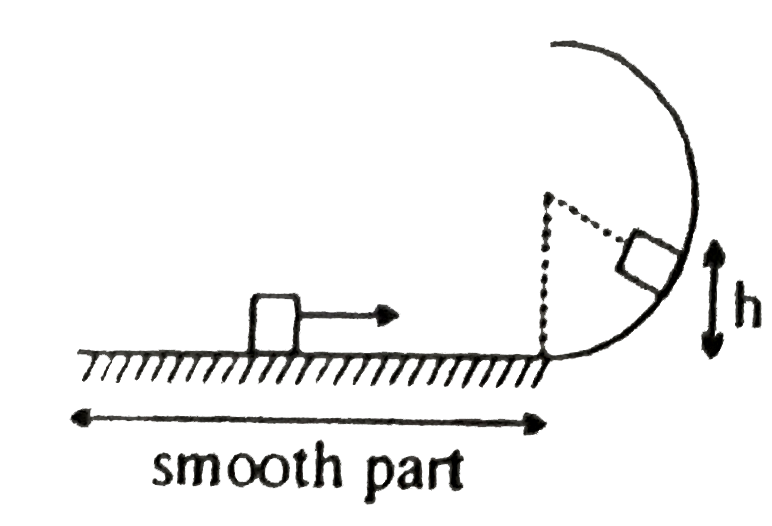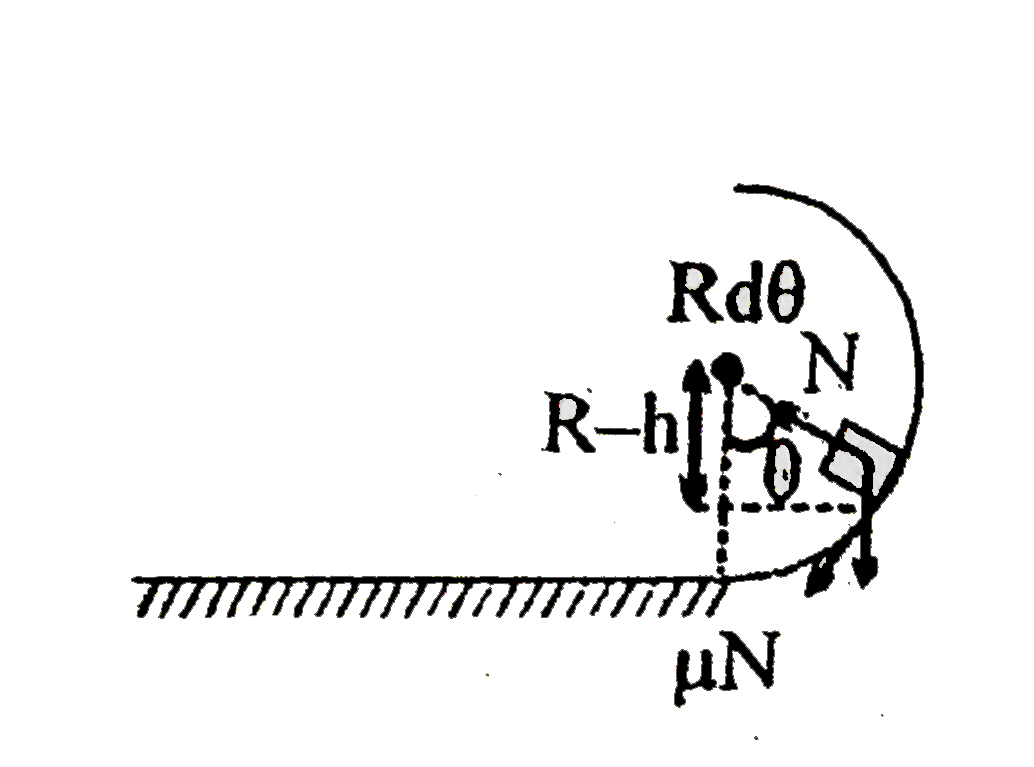An object of mass m is slowly pushed some partway up a verticle up a verticle loop ending at a point a height h<R above the bottom. The coefficient of friction between the object and the track is a constant mu. Find work that has to be done against friction.

2μmg(2hR−h2)1/2
μmg(hR−2h2)1/2
4μmg(2hR−h2)1/2
μmg(2hR−h2)1/2
The correct Answer is:D
WD =θ0∫0μmgcosθRdθ
=μmgRsinθ0
=μmg[R2−(R−h)2]1/2
=μmg[2Rh−h2]1/2

Topper's Solved these Questions
- MASTER PRACTICE PROBLEMBook:BANSALChapter:MASTER PRACTICE PROBLEMExercise:Subjective
Explore 107 Videos
- MASTER PRACTICE PROBLEMBook:BANSALChapter:MASTER PRACTICE PROBLEMExercise:Additional topic
Explore 70 Videos
- MASTER PRACTICE PROBLEMBook:BANSALChapter:MASTER PRACTICE PROBLEMExercise:Reasoning
Explore 75 Videos
- FLUID MECHANICSBook:BANSALChapter:FLUID MECHANICSExercise:PYQS AIEEE
Explore 10 Videos
- SEMICONDUCTORSBook:BANSALChapter:SEMICONDUCTORSExercise:CBSE Question
Explore 32 Videos
Similar Questions
A body of mass 0.3kg is taken up an inclined plane of length 10m and height 5m, and then allowed to slide down to the bottom again. The coefficient of friction between the body and the plane is 0.15.
What is the
(a) work done by the gravitational force over the round trip ?
(b) work done by the applied force on the upward journey ?
(c) work done by the frictional force over the round trip ,
(d)kinetic energy of the body at the end of the trip ?
View SolutionA body of mass 0.3 kg is taken up an inclined plane of length 10 m and height 5 m, and then allowed to slide down the bottom again. The coefficient of friction between the body and the plane is 0.15. What is the
(i) work done by the applied force over the upward journey?
(ii) work the by gravitational force over the round trip?
(iii)work the by the frictional force over the round trip?
Which of the above forces (except applied force )is/are conservative forces?
View Solution
Knowledge Check
A body of mass m is moved up (slowly) the plane of verying slope by a tangential force upto height h. The coefficient of friction between the surface and the block is μ.

Select correct option(s)AThe work done by gravity on the block from A to B depends upon the height h.BThe work done by gravity on the block from A to B do not depends upon the height h.CTotal work done by all forces on the block from A to B is zeroDFrom A to B work done by friction force on the block is negative.A body of mass m is moved up (slowly) the plane of verying slope by a tangential force upto height h. The coefficient of friction between the surface and the block is μ.

Select correct option(s)AThe friction force on the block is Kinetic and variable in magnitudeBFrom A to B work done by frication on the block is −μmgx.CFrom A to B work done by frication on the block is −μmgx√h2−x2DFrom A to B work done by F on the block is mgh.A body of mass 0.5 kg is taken up an inclined plane of length 10 m and height 5 m and then allowed to slide down to the bottom again. The coefficient of friction between the body and the plane is 0.1. The work done by the frictional force over the round trip is
A5 JB5√3JC−5JD−5√3J
A block of mass m kg is pushed up against a wall by a force P That makes an angle 'theta' with the horizontal as shown in The coefficient of static friction between the block and the wall is μ The minimum value of P that allows the block to remain stationary is .
View SolutionA body of mass 0.3kg is taken up an inclined plane of length 10m and height 5m, and then allowed to slide down to the bottom again. The coefficient of friction between the body and the plane is 0.15.
What is the
(a) work done by the gravitational force over the round trip ?
(b) work done by the applied force on the upward journey ?
(c) work done by the frictional force over the round trip ,
(d)kinetic energy of the body at the end of the trip ?
View SolutionA block of mass m kg is pushed up against a wall by a force P that makes an angle 'θ' with the horizontal as shown in figure . The coefficient of static friction between the block and the wall is μ . Find the minimum value of P that allows the block to remain stationary .
View SolutionA body is moving up an inclined plane of angle θ with an anitial kinetic energy E. The coefficient of friction between the plane and body is μ. The work done against friction before the body comes to rest is
View SolutionA block of mass m sliding down an inclined at constant speed is initial at a height h shown the ground as shown in the figure above . The coefficient of kinetic friction between the mass and the inclined is μ . If the mass constinues to slide down the inclined at a constant speed how much energy is displaced by friction by the time the mass reaches the bottom of the incline?

View Solution

